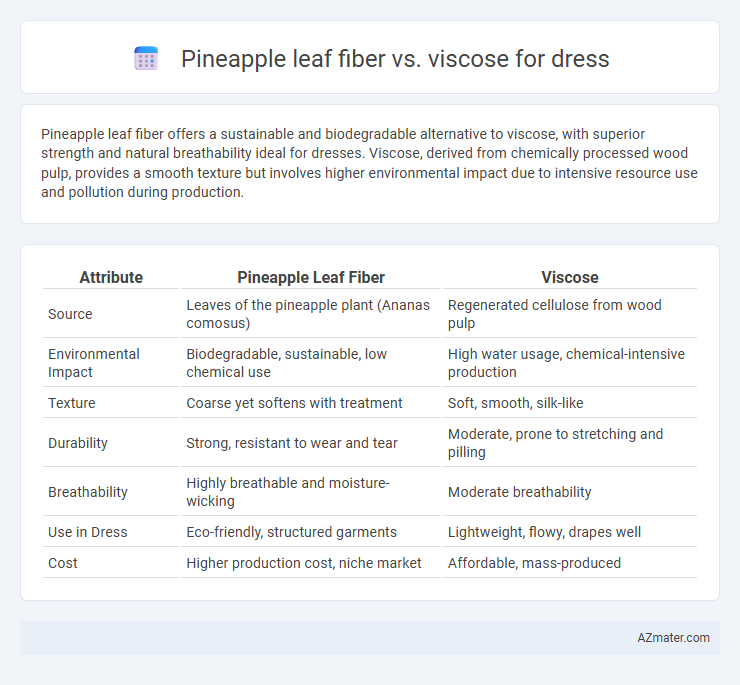Pineapple leaf fiber offers a sustainable and biodegradable alternative to viscose, with superior strength and natural breathability ideal for dresses. Viscose, derived from chemically processed wood pulp, provides a smooth texture but involves higher environmental impact due to intensive resource use and pollution during production.
Table of Comparison
| Attribute | Pineapple Leaf Fiber | Viscose |
|---|---|---|
| Source | Leaves of the pineapple plant (Ananas comosus) | Regenerated cellulose from wood pulp |
| Environmental Impact | Biodegradable, sustainable, low chemical use | High water usage, chemical-intensive production |
| Texture | Coarse yet softens with treatment | Soft, smooth, silk-like |
| Durability | Strong, resistant to wear and tear | Moderate, prone to stretching and pilling |
| Breathability | Highly breathable and moisture-wicking | Moderate breathability |
| Use in Dress | Eco-friendly, structured garments | Lightweight, flowy, drapes well |
| Cost | Higher production cost, niche market | Affordable, mass-produced |
Introduction to Pineapple Leaf Fiber and Viscose
Pineapple leaf fiber, derived from the long leaves of pineapple plants, is a natural, eco-friendly textile known for its strength, breathability, and sustainability, making it an innovative alternative to traditional fabrics. Viscose, a semi-synthetic fiber made from cellulose extracted from wood pulp, offers a smooth, soft texture and excellent drape, but involves chemically intensive production processes. Comparing these fibers highlights the environmental benefits of pineapple leaf fiber as a biodegradable, renewable resource versus the viscose's reliance on intensive chemical treatments and deforestation risks.
Origin and Production Process
Pineapple leaf fiber is derived from the leaves of the pineapple plant, harvested primarily in Southeast Asia, and extracted using a mechanical decortication process that separates the fiber from the leaf veins. Viscose, a type of rayon, is produced through a chemical process that transforms cellulose from wood pulp or bamboo into a regenerated fiber via xanthation and spinning. The natural, eco-friendly origin of pineapple leaf fiber contrasts with the chemically intensive production of viscose, impacting sustainability and texture in dress materials.
Environmental Impact and Sustainability
Pineapple leaf fiber is an eco-friendly, biodegradable material derived from agricultural waste, which reduces landfill contributions and requires minimal water and pesticides compared to viscose production. Viscose, made from chemically treated wood pulp, involves intensive water use and toxic chemicals, leading to significant environmental pollution and deforestation risks. Choosing pineapple leaf fiber over viscose supports sustainable fashion by lowering carbon footprint and promoting the use of renewable plant-based resources in dress manufacturing.
Fiber Properties and Characteristics
Pineapple leaf fiber boasts exceptional strength, high durability, and natural moisture-wicking properties, making it an eco-friendly and breathable choice for dresses. In contrast, viscose offers a silky texture and excellent drape but is less durable and prone to wrinkling due to its semi-synthetic cellulosic nature. Pineapple leaf fiber's inherent stiffness contrasts with viscose's softness, impacting garment structure and longevity.
Comfort and Breathability
Pineapple leaf fiber offers exceptional breathability and natural moisture-wicking properties, making it highly comfortable for dress materials, especially in warm climates. Viscose, derived from cellulose, provides a soft and smooth texture but often retains more heat and moisture, which may reduce overall comfort during extended wear. The sustainable nature of pineapple leaf fiber also adds an eco-friendly advantage without compromising on breathability or comfort compared to viscose.
Durability and Longevity
Pineapple leaf fiber is renowned for its superior durability and resistance to wear compared to viscose, making it an excellent choice for long-lasting dresses. Unlike viscose, which tends to weaken and lose shape over time due to its semi-synthetic nature, pineapple leaf fiber maintains structural integrity and strength through repeated use and washing. This natural fiber's high tensile strength and moisture-wicking properties contribute to the longevity and sustained appearance of dresses crafted from it.
Aesthetic Qualities in Dresses
Pineapple leaf fiber offers a unique texture with a natural sheen, giving dresses an artisanal, eco-friendly appearance that highlights sustainable fashion trends. Viscose, known for its smooth drape and vibrant color absorption, provides dresses with a silky, refined finish ideal for elegant and formal wear. The rigid structure of pineapple leaf fiber contrasts with the fluidity of viscose, making each material suitable for distinct aesthetic styles in dress design.
Cost and Market Availability
Pineapple leaf fiber offers a sustainable and eco-friendly alternative to viscose, but its higher production costs limit widespread market availability compared to viscose, which benefits from established manufacturing processes and lower prices. Viscose remains more accessible in mainstream dress markets due to its cost-effectiveness and consistent supply, while pineapple leaf fiber is primarily found in niche or artisanal fashion segments. Consumers seeking environmentally conscious options may face higher prices and limited choices when opting for pineapple leaf fiber dresses.
Suitability for Fashion Design
Pineapple leaf fiber offers a sustainable and eco-friendly alternative to viscose, providing a unique texture and natural sheen that appeals to designers seeking organic materials for fashion design. Its durability and breathability make it suitable for structured dresses and avant-garde suits, while viscose, derived from wood pulp, is prized for its softness, drape, and versatility in creating fluid, comfortable garments. Pineapple leaf fiber suits designers aiming for an innovative, high-performance fabric with environmental benefits, whereas viscose suits those prioritizing affordability and a wide range of finish options for diverse fashion aesthetics.
Conclusion: Choosing the Right Fiber for Dresses
Pineapple leaf fiber offers an eco-friendly, biodegradable option with natural texture and durability, ideal for sustainable fashion enthusiasts seeking unique dress materials. Viscose provides a smooth, soft, and breathable fabric with vibrant color retention, suitable for affordable and comfortable everyday dresses. Selecting the right fiber depends on prioritizing sustainability and texture with pineapple leaf fiber or opting for versatility and softness with viscose in dressmaking.

Infographic: Pineapple leaf fiber vs Viscose for Dress
 azmater.com
azmater.com